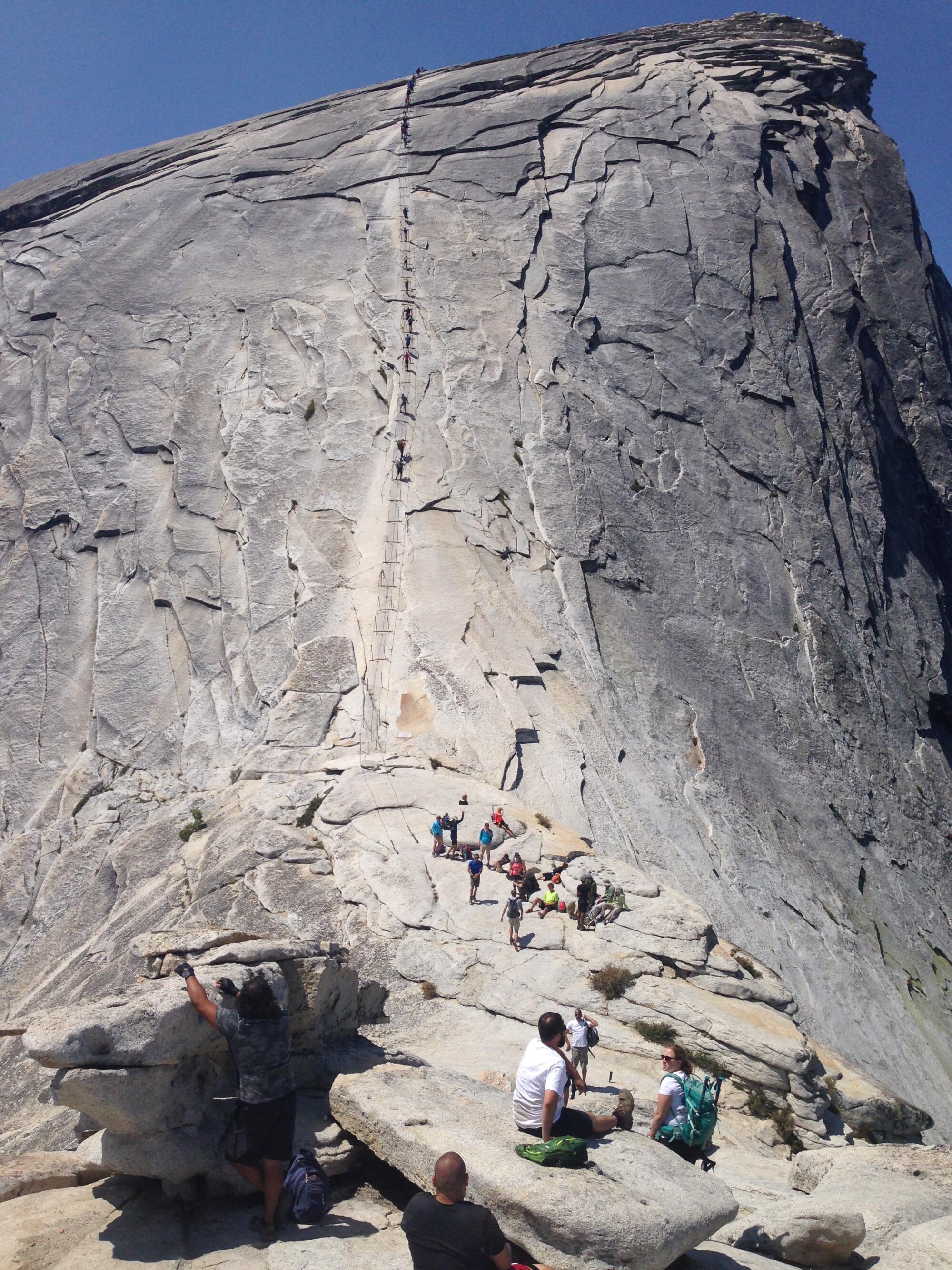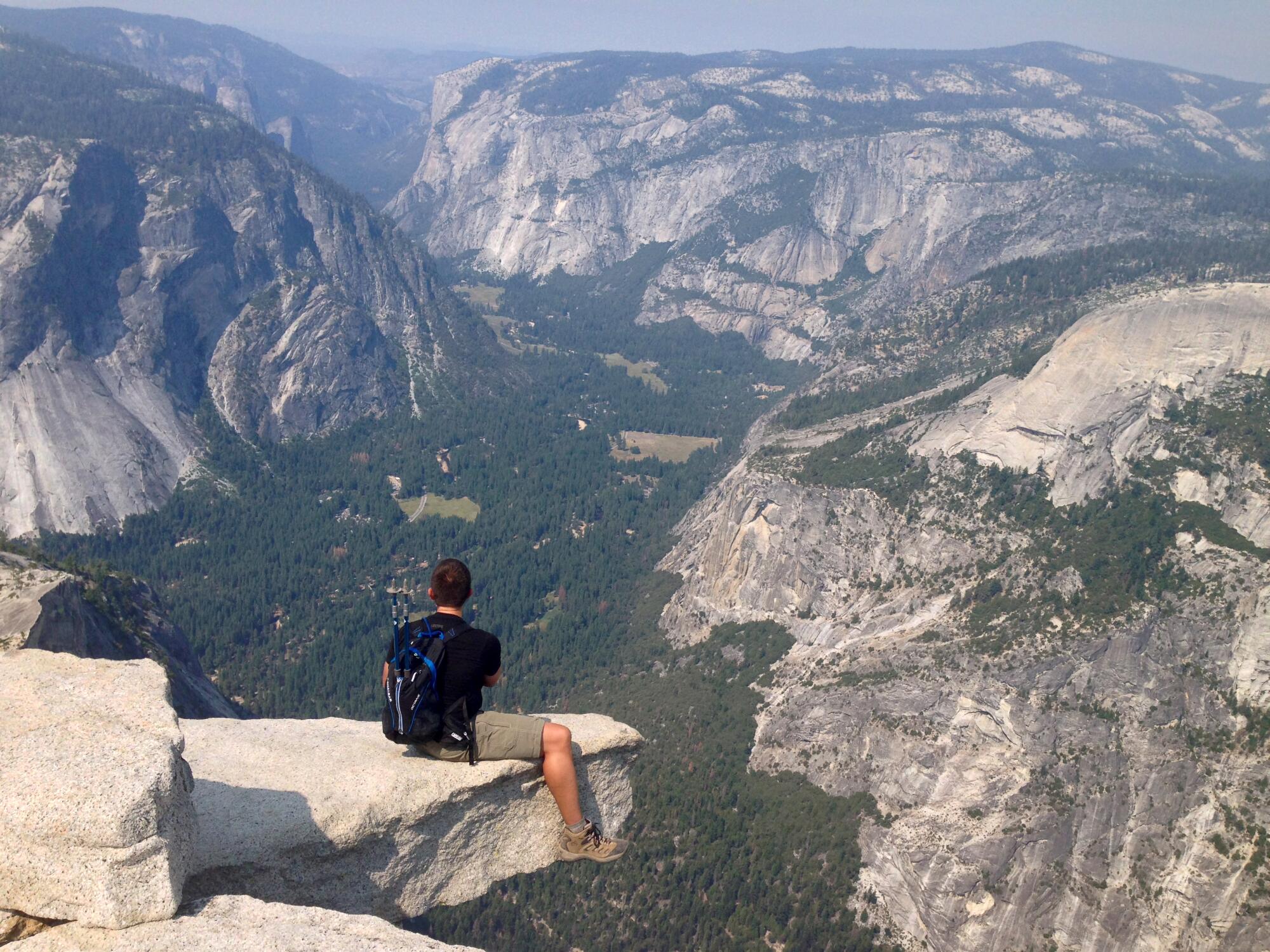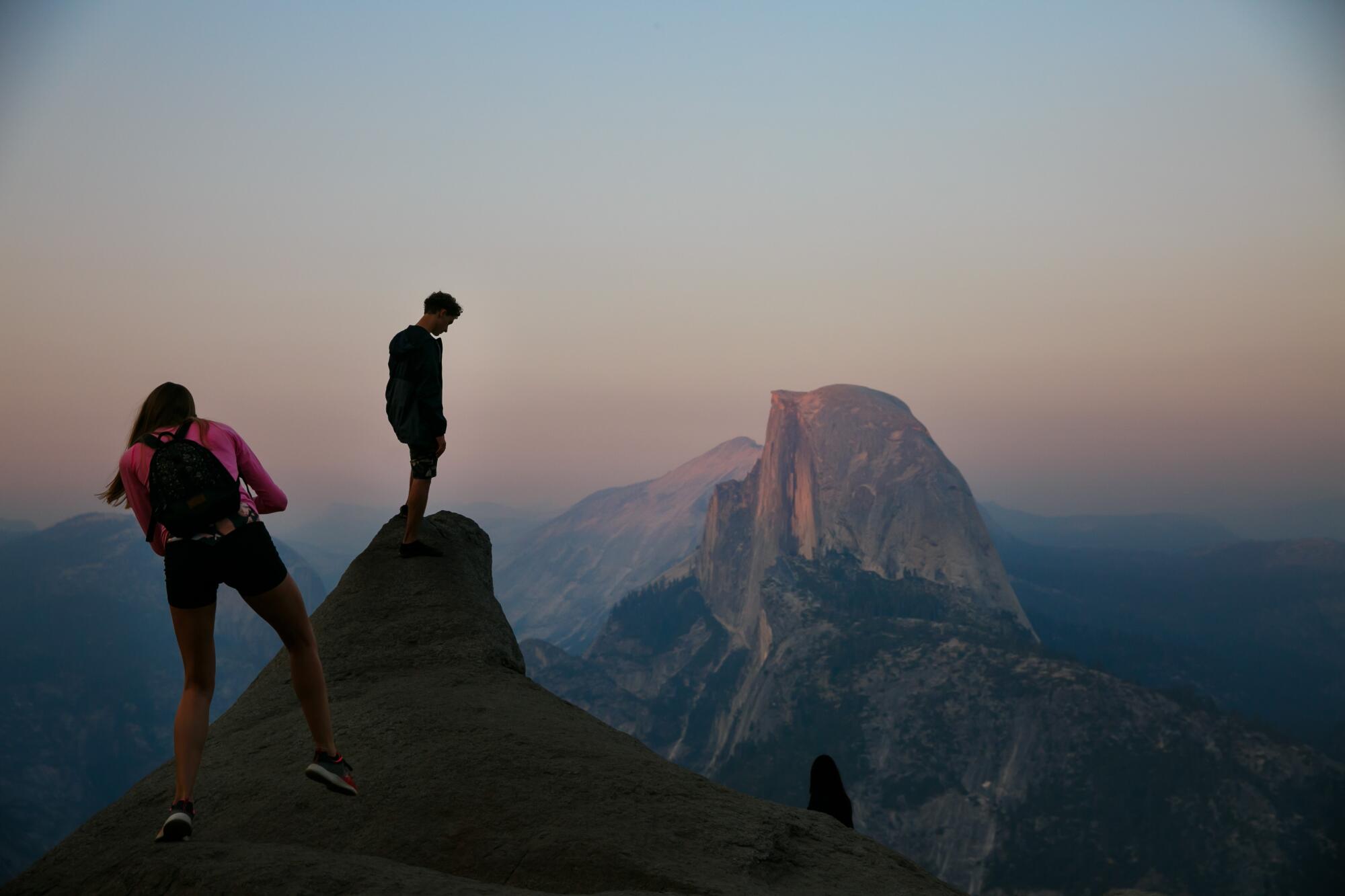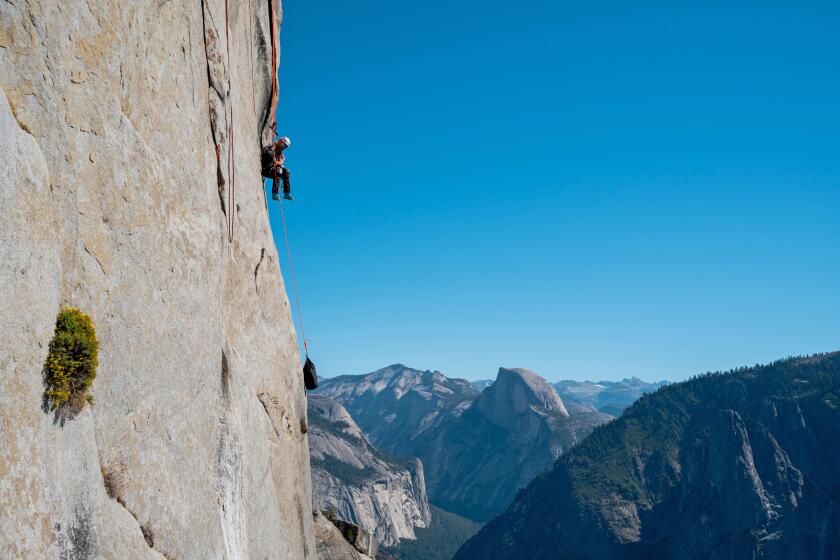
- Share via
YOSEMITE NATIONAL PARK — Clinging for life to a cold steel cable, high on a nearly vertical rock face in the Sierra Nevada, the soles of my hiking shoes simply could not find traction.
Again and again, as my forearms trembled and my fingers ached, my feet slipped on the mercilessly smooth granite.
A fall from that height — on the climbing cables that mark the final 400-foot ascent to the summit of Yosemite’s Half Dome — could easily be fatal. So I clenched my fists tighter and inched toward the top. The only relief came from irregularly spaced wooden slats drilled into the rock that provided desperately needed footholds.
I was right to be nervous. The wide stretches between some of those wooden slats, particularly on the steepest parts of the final ascent, are notoriously treacherous.
Last month, while descending the same stretch in a sudden rainstorm, 20-year-old Grace Rohloff slipped on the slick rock and lost her grip on the cables. In a flash, she slid past her father’s outstretched hand, and he watched helplessly as she plummeted hundreds of feet to her death.

She wasn’t the first: At least 10 others have died in falls from that stretch, usually when the rock is wet.
In a phone interview last week from his home in Phoenix, Jonathan Rohloff said he kept asking himself during their perilous descent: “Why is this wood so far apart?” He guessed it would cost a few thousand dollars to double the number of rungs. That’s a sum he figured could easily be collected from the 50,000 people who pay for $10 permits to climb Half Dome each year.
Which leaves him wondering why nothing has been done to address the obvious risk.
“My daughter’s life was worth way more than a few thousand dollars,” he said.
The need for safety improvements was also top-of-mind for more than a dozen climbers interviewed at the cables last week. All of them had followed the tragic news about Rohloff’s daughter.
They were men and women from across the country, ranging in age from 18 to 54. Among them were experienced mountaineers accustomed to steep terrain where any fall could be fatal, and casual hikers who had never before attempted to climb anything as hair-raising. They all agreed on one thing: More secure footholds would be welcome.
“I would definitely appreciate more wooden rungs,” said Ruthie Smith, 25, from Cincinnati, while celebrating with her friends on the summit and trying not to think too much about the looming descent.
On the way up, someone had passed Smith and jostled the cable in one of the wide stretches between the wood slats. “My grip was the only thing holding me on,” she said. “It would have been so easy to slip.”
Hudson Sauder, from Livermore in the Bay Area, had a similar experience.

“I consider myself a strong 19-year-old guy,” he said. “I thought it would be a breeze to scamper up.” That was until his feet started slipping despite the sticky-soled running shoes he’d bought specifically for the climb. “I was scared my grip strength would go,” he said. “It would have been a nightmare.”
Juan Santiago, 39, from Dallas, still catching his breath at the top of the cables, said the upper-body strength required just to hang onto them had come as a shock — and joked that it left him “questioning a lot of my life decisions.” Doubling the number of wooden slats, he added, would be a great idea.
Yosemite National Park administrators declined to answer questions from The Times about the possibility of adding more safeguards and what that might cost.
Rohloff said he told the park rangers who interviewed him after his daughter’s death that “Grace died because the cables are unnecessarily dangerous.” But he has heard nothing from park officials about any planned improvements.
“The silence has been deafening,” he said.
Danger and drama on Half Dome’s cables are nothing new. They have been around for more than a century, and they’re almost as iconic as the summit’s unmistakable silhouette.
Braving them is a rite of passage among California’s outdoors enthusiasts — something people tend to do once and remember for the rest of their lives.
The cables came into being in the late 1800s, after celebrated geologist Josiah Whitney proclaimed the 8,800-foot summit of Half Dome “perfectly inaccessible” and declared it would “never be trodden by human foot.”
A Yosemite guide named George Anderson decided to prove him wrong.
Mountaineering was in its infancy at the time, and the methods were crude. Anderson attacked the problem by pounding huge holes into the rock and filling them with heavy steel anchors — a practice that is polar opposite of the “leave no trace” philosophy popular today.

Anderson reached the summit for the first time in October 1875, according to the Yosemite Mariposa County Tourism Board. The cable system, which consists of two braided steel lines supported by vertical steel posts, was installed in 1919. It has been modified since then, but not much.
The cables are ugly, crude and dangerous, but they have fascinated adventurous souls since Day 1.
Perhaps that’s because most of us will never scale the towering rock walls that make Yosemite the holy land for hard-core climbers.
Conquering El Capitan, the 3,000-foot vertical face on the other side of Yosemite Valley, is arguably the crowning achievement in any technical climber’s career. Even the nearly vertical north face of Half Dome is out of the question for all but the most experienced climbers.
In 2015, mountain guide Zuko Carrasco’s world collapsed in a trust fall gone awry. Eight years later, he looked to reclaim his independence with an audacious plan to scale El Capitan.
But thanks to the cables, any fit flatlander with a firm grip and steely nerves has a decent chance of making it up the backside of Half Dome — if the weather cooperates. In the process, they get just a little taste of the heart-pounding drama experienced by elite adventure athletes.
Over the years, the question of what, if anything, should be done to make the system safer has been the topic of spirited debate. One argument against improving the cables is that it might make them too easy, luring people who are not fit enough to safely give them a try.
But just getting to the base of the cables requires a substantial level of preparation and fitness.
First, you have to join the park’s online lottery system that opens months before the summer climbing season and hope to win a permit. The park limits the number of people who can climb Half Dome to 300 per day, a cap aimed, in part, at reducing gridlock on the cables. If you go without a permit, and get caught, there’s a $280 fine.
Then there’s the grueling hike itself. My round trip from the closest parking to the trailhead in Yosemite Valley covered more than 18 miles and climbed more than 5,000 vertical feet, according to the fitness app Alltrails. That’s a long day no matter who you are; it would be virtually impossible for someone who was in poor shape.
Another serious obstacle is the weather. The last place you want to be when it rains, or during a lightning storm, is clinging to a steel cable on slippery granite high above the treeline. Injuries have occurred in bad weather when climbers simply freeze in place with terror and others resort to risky maneuvers to try to get around them.

When it comes to gear, the most important thing to have is a good pair of gloves. The best are those worn by electricians: thin with sticky rubber palms that form a strong bond with the steel cables. There’s often a pile of them donated by other climbers at the base of the cables, but park officials discourage the practice, saying it’s a chore to clear away hundreds of pounds of rotting gloves left behind each year.
Some people take the extra step of wearing a climbing harness with lines they can attach to the cables. This will slow you down, because you’re regularly unclipping and clipping back in to get past the vertical posts. That can be irritating to more confident climbers who are stuck waiting behind you, but it provides another layer of potentially life-saving protection in case you lose your grip.
Such a harness, properly used, probably would have saved Grace Rohloff.
Even with all the right preparation and gear, some people get to the base of the cables, crane their necks to survey the route almost straight up the sheer rock face, and decide there’s simply no way.
“I was just like, it’s a hard no,” said Grace Luttrell, 33, from Oakland, who decided to wait at the base and nibble a sandwich as her friends went on to the summit.
“You see all different kinds of people going up: fitness levels, ages, whatever. And I feel like there’s a lot of pressure to push yourself to give it a try,” Luttrell said. “But I have no regrets.”
Another athletic-looking woman who had all the appropriate gear went about a quarter of the way up the cables, before abruptly turning around. “This is scary. This is so scary,” she muttered as she passed me, furiously clipping and unclipping as she descended. “This is not my thing.”
Another argument against drilling more wooden rungs into the rock is rooted in the 21st century aversion to adding anything fashioned by humans to the natural environment. But since the cables are already there, none of the climbers interviewed thought improving them would mar the landscape.
“This isn’t really wilderness anymore,” said Erick Ulferts, 54, from Portland, Ore., as he took a few deep breaths and a long look back at the cables after safely descending. Adding more footholds wouldn’t “change things dramatically.”
He had worn a climbing harness, but that didn’t stop his feet from sliding out from under him on the smooth granite. At one point, he slipped and nearly fell where one of the steel posts would have gone straight between his legs.
“None of this is especially safe,” he said with a wry grin. “That’s sort of the beauty of it.”
For Rohloff, an elementary school principal who is still reeling from the horror of watching the oldest of his three children slide to her death, the goal is to get park officials to commit to making Half Dome safer.
“To me, there’s such a commonsense thing that could be done and has not been done,” Rohloff said of adding some rungs. “It’s hard for me to believe I’m the first person to feel this way.”
More to Read
Sign up for Essential California
The most important California stories and recommendations in your inbox every morning.
You may occasionally receive promotional content from the Los Angeles Times.












